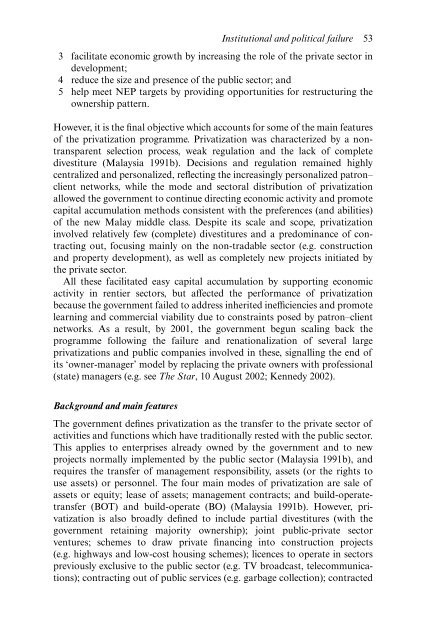PRIVATIZATION Privatization in Malaysia, Regulation, rent-seeking and policy failure
PRIVATIZATION Privatization in Malaysia, Regulation, rent-seeking and policy failure
PRIVATIZATION Privatization in Malaysia, Regulation, rent-seeking and policy failure
You also want an ePaper? Increase the reach of your titles
YUMPU automatically turns print PDFs into web optimized ePapers that Google loves.
Institutional <strong>and</strong> political <strong>failure</strong> 533 facilitate economic growth by <strong>in</strong>creas<strong>in</strong>g the role of the private sector <strong>in</strong>development;4 reduce the size <strong>and</strong> presence of the public sector; <strong>and</strong>5 help meet NEP targets by provid<strong>in</strong>g opportunities for restructur<strong>in</strong>g theownership pattern.However, it is the f<strong>in</strong>al objective which accounts for some of the ma<strong>in</strong> featuresof the privatization programme. <strong>Privatization</strong> was characterized by a nontranspa<strong>rent</strong>selection process, weak regulation <strong>and</strong> the lack of completedivestiture (<strong>Malaysia</strong> 1991b). Decisions <strong>and</strong> regulation rema<strong>in</strong>ed highlycentralized <strong>and</strong> personalized, reflect<strong>in</strong>g the <strong>in</strong>creas<strong>in</strong>gly personalized patron–client networks, while the mode <strong>and</strong> sectoral distribution of privatizationallowed the government to cont<strong>in</strong>ue direct<strong>in</strong>g economic activity <strong>and</strong> promotecapital accumulation methods consistent with the preferences (<strong>and</strong> abilities)of the new Malay middle class. Despite its scale <strong>and</strong> scope, privatization<strong>in</strong>volved relatively few (complete) divestitures <strong>and</strong> a predom<strong>in</strong>ance of contract<strong>in</strong>gout, focus<strong>in</strong>g ma<strong>in</strong>ly on the non-tradable sector (e.g. construction<strong>and</strong> property development), as well as completely new projects <strong>in</strong>itiated bythe private sector.All these facilitated easy capital accumulation by support<strong>in</strong>g economicactivity <strong>in</strong> <strong>rent</strong>ier sectors, but affected the performance of privatizationbecause the government failed to address <strong>in</strong>herited <strong>in</strong>efficiencies <strong>and</strong> promotelearn<strong>in</strong>g <strong>and</strong> commercial viability due to constra<strong>in</strong>ts posed by patron–clientnetworks. As a result, by 2001, the government begun scal<strong>in</strong>g back theprogramme follow<strong>in</strong>g the <strong>failure</strong> <strong>and</strong> renationalization of several largeprivatizations <strong>and</strong> public companies <strong>in</strong>volved <strong>in</strong> these, signall<strong>in</strong>g the end ofits ‘owner-manager’ model by replac<strong>in</strong>g the private owners with professional(state) managers (e.g. see The Star, 10 August 2002; Kennedy 2002).Background <strong>and</strong> ma<strong>in</strong> featuresThe government def<strong>in</strong>es privatization as the transfer to the private sector ofactivities <strong>and</strong> functions which have traditionally rested with the public sector.This applies to enterprises already owned by the government <strong>and</strong> to newprojects normally implemented by the public sector (<strong>Malaysia</strong> 1991b), <strong>and</strong>requires the transfer of management responsibility, assets (or the rights touse assets) or personnel. The four ma<strong>in</strong> modes of privatization are sale ofassets or equity; lease of assets; management contracts; <strong>and</strong> build-operatetransfer(BOT) <strong>and</strong> build-operate (BO) (<strong>Malaysia</strong> 1991b). However, privatizationis also broadly def<strong>in</strong>ed to <strong>in</strong>clude partial divestitures (with thegovernment reta<strong>in</strong><strong>in</strong>g majority ownership); jo<strong>in</strong>t public-private sectorventures; schemes to draw private f<strong>in</strong>anc<strong>in</strong>g <strong>in</strong>to construction projects(e.g. highways <strong>and</strong> low-cost hous<strong>in</strong>g schemes); licences to operate <strong>in</strong> sectorspreviously exclusive to the public sector (e.g. TV broadcast, telecommunications);contract<strong>in</strong>g out of public services (e.g. garbage collection); contracted


